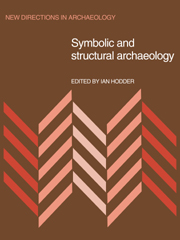Book contents
- Frontmatter
- Contents
- List of contributors
- Preface
- Part one The development of theory
- Part two The search for models
- Part three Application: the analysis of archaeological materials
- 11 Boundedness in art and society
- 12 Ideology, symbolic power and ritual communication: a reinterpretation of Neolithic mortuary practices
- 13 Ideology, change and the European Early Bronze Age
- 14 Sequences of structural change in the Dutch Neolithic
- Part four Commentary
- Index
13 - Ideology, change and the European Early Bronze Age
Published online by Cambridge University Press: 27 February 2010
- Frontmatter
- Contents
- List of contributors
- Preface
- Part one The development of theory
- Part two The search for models
- Part three Application: the analysis of archaeological materials
- 11 Boundedness in art and society
- 12 Ideology, symbolic power and ritual communication: a reinterpretation of Neolithic mortuary practices
- 13 Ideology, change and the European Early Bronze Age
- 14 Sequences of structural change in the Dutch Neolithic
- Part four Commentary
- Index
Summary
Shennan examines economic, political and ideological change in the development of a bronze industry and in the appearance of particularly rich graves at the end of the Neolithic and beginning of the Bronze Age in Europe. In Wessex, southeast Spain and Brittany there is evidence for the development first of a hierarchy legitimated by communal ritual, and later by the naturalisation of hierarchy in the material symbols associated with individuals, for example at burial. There was thus a change in the representation of social hierarchy. In central Europe, on the other hand, the growth of a hierarchy is associated directly with individual burial differentiation. The adoption of the latter mode of representation in western Europe was associated with the spread of Bell Beakers and the overall structure, which is characterised by continual change and search for material items of prestige, plays a part in the development of the Early Bronze Age metal industry. It is emphasised that both the local and interregional contexts need to be examined in the explanation of change.
The end of the Neolithic and the beginning of the Bronze Age (c. 2500–1500 BC) have long been seen as a period of significant change in European prehistory. This inference has been based on the marked changes visible in certain aspects of the archaeological record in many parts of Europe at this time, and also on the assumption implicit in the Three Age system that the transition from one age to another must be of considerable importance. Two aspects of the archaeological record have elicited particular attention, the appearance of bronze artefacts and that of burials containing relatively spectacular grave goods.
- Type
- Chapter
- Information
- Symbolic and Structural Archaeology , pp. 155 - 161Publisher: Cambridge University PressPrint publication year: 1982
- 38
- Cited by



